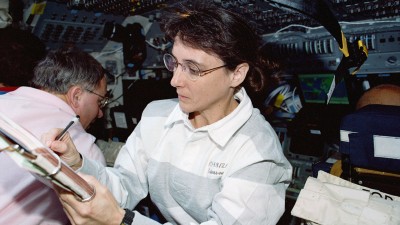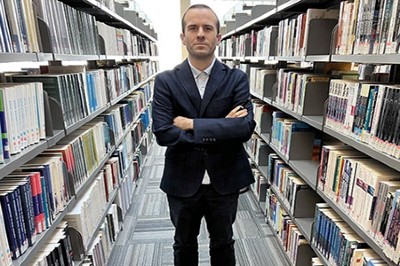
Working in a group can give a sense of community to the process of writing grant applications.Credit: Getty
What words come to mind when you think of preparing research proposals? The odds are that ‘excited’ and ‘happy’ are not among them. We regularly provide grant-writing training to academics of all career stages at Stanford University in California, and we’ve seen up close how they can struggle with the process. We have collected years of survey data in which researchers describe writing grant applications as burdensome, tedious, overwhelming and lonely. As one early-career scientist put it, grant writing is “a necessary evil”.
These feelings are valid. Grant writing is hard. It’s time-consuming. It can feel isolating and can sap your motivation. For many scientists, it is their least favourite part of the job.
How to gain a competitive edge in grant writing
We offer a radical reframing by training people to welcome joy into the process. Think about it: don’t you work better when you enjoy what you’re doing? Why not apply this concept to grant writing?
Our three strategies make the process more enriching, not just financially but also socially and emotionally. They are at the core of our programme, and although they might initially be received with scepticism, participants often discover a new, and more productive, approach to grant writing.
Strategy 1: reconnect with your purpose
We become scientists to satisfy our intellectual curiosity through investigation and discovery, to advance a given field and to have positive impact on society. But these big-picture motivators can get lost in the busy day-to-day reality.
A funding adviser’s guide to writing a great grant application
Writing proposals provides an opportunity to revisit, revise and reprioritize your goals, think creatively about your strategy and receive feedback from an interdisciplinary community of scientists whose insights can strengthen your research programme and increase its impact. Done right, grant writing can reconnect you with the joy that led you to became a scientist in the first place. As one early-career researcher told us: “I am reframing grant writing as one of the most fun things we get to do — we have total control over the ideas we pursue and who we bring together to pursue those ideas. What a gift!”
In addition to reframing your purpose, also rethink your perspective on the process itself. Sharing your research ideas can be unnerving; a ‘rejection’ can feel like an attack. This isn’t a productive mindset. Instead, try to view feedback as peer suggestions that increase the impact of your research. Approaching the review process as a protracted conversation between the funder, grant writer and reviewers can lessen the sting if your proposal isn’t funded, because it gives you the power to decide whether to respond or move on. Although rejection is painful, this reframing can help you remain engaged and empower you to try again.
Strategy 2: think like a writer
“As a scientist,” writes Joshua Schimel in his 2011 book Writing Science, “you are a professional writer.”
To accelerate your impact, you need to commit yourself to writing regularly. For example, you might begin each Monday, Tuesday and Friday with a cup of tea and at least an hour of distraction-free writing. Increase your writing time as the proposal’s due date nears. A deliberate writing routine provides structure and reduces the panic and fear you feel when faced with a blank page.
ChatGPT use shows that the grant-application system is broken
Grants applications are complex, multicomponent documents, and they can seem overwhelming. But when you break them down, the process becomes more manageable. For example, instead of thinking about your research proposal as a whole, why not reduce your specific research goals to smaller, more manageable items that you can tackle one at a time.
Also, make time in your weekly schedule to explore. Read articles or attend talks inside and outside your immediate field and think about possible connections to your work. Investing a little time in weekly reflection on what you’ve learnt or read enriches your research by enabling you to connect ideas in unexpected ways, resulting in innovation.
Strategy 3: build community
Tap into existing affinity groups at your institution by networking with people with whom you share common interests. For example, early-career faculty members have a shared goal of securing grants as they prepare for tenure and might have a vested interest in being part of a writing group. You could draw on this connection as you start to build a writing community. Alternatively, you could work with administrative or research development offices to connect you with grant writers in your area.
Nature Collection: Funding science
Once you have a writing group, leverage it to make yourself accountable. For example, begin sessions by declaring your writing plans. This could look like going around the room (or Zoom) and getting each person to state their writing goals for that day. For example, “I’m going to write the introduction for my second aim.” Sharing your goals sets a clear intention; the group can then check in on how everyone’s doing at the end of the session. This allows others to be invested in your progress and serves as a source of accountability. Active celebration of each other’s achievements enhances joy, strengthens belonging and leads to more connected and innovative communities.
Writing groups can also serve as places to practise thinking like a reviewer and receiving effective feedback. When delivered well (for example, when structured in sentences starting with ‘I like’, ‘I wish’ and ‘what if’), peer review is valuable, because a trusted peer can tell you where they got ‘stuck’ or when something didn’t make sense. Having a fresh set of eyes strengthens your proposal and gives you practice in viewing your proposal as a reviewer would.
As scientists, we spend a lot of time and energy on writing grant applications. By embracing these strategies, we can begin to centre our grant-writing experiences with joy and community — and, hopefully, with more success.
Competing Interests
The authors declare no competing financial interests.




